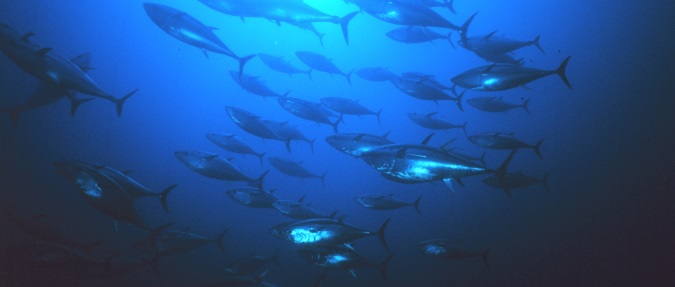
Stock assessment indicates that management measures already in place are likely to help. Scientists just completed a new, improved stock assessment of the Pacific bluefin tuna population which suggests that the stock was still quite low in 2014, but up from 2012 numbers.
The Pacific Bluefin Tuna Working Group of the International Scientific Committee for Tuna and Tuna-Like Species in the North Pacific Ocean (ISC) including scientists from government fisheries agencies of the region (Japan, Korea, Mexico, Taiwan, USA) and the Inter-American Tropical Tuna Commission completed the Pacific bluefin stock assessment in March at Southwest Fisheries Science Center (SWFSC) in La Jolla, California, USA. The stock assessment indicates that the size of the Pacific bluefin spawning stock in 2014 was only 2.6% of its “unfished” size in 2014, compared to 2.0% in 2012. This represents a potential increase in the stock biomass from 2012 to 2014.
The unfished biomass level is the current amount of fish in the population compared to the amount if fishing had not occurred at all. The spawning biomass is the amount of fish that are reproductively mature. It does not include the immature (or juvenile) fish, which are the only bluefin we find in the Eastern Pacific Ocean feeding grounds. ISC scientists also determined that the recruitment, or the survival level of young fish, has been historically low the past three years, but not the lowest ever. “ R ecent recruitment estimates are similar to those seen in the 1980s, which were the lowest estimated.” said Dr. Hui-Hua Lee, lead scientist at NOAA Fisheries working on the assessment.
The previous Pacific bluefin stock assessment (in 2014) concluded that there was 4.2% of the unfished spawning biomass in 2012. The decline from 4.2% (2014 assessment) to 2.0% (2016 assessment) is not due to a decline in the population. It represents an enhancement in the model and an overall downward shift in the numbers of fish in the last 30 years. “We are confident in the results, that the Pacific bluefin stock is significantly depleted, and possibly increasing in numbers. We are also pleased with the improvements in the assessment model,” said Lee.
ISC finalized the assessment at its Plenary meeting in July 2016. “At this point, managers are be able to use it,” stated Dr. Gerard DiNardo, ISC Chair.
The results of the 2016 assessment did not reflect the impact of the more restrictive management measures adopted in 2014 because they were implemented for 2015 and 2016. Data from 2015 and 2016 will be considered in the next assessment. However, the assessment projected the impact of existing and hypothetical management measures on the status of the stock as of 2014. They indicate that the management measures implemented in 2015 and 2016 are likely to achieve the Western and Central Pacific Fisheries Commission’s (WCPFC) interim target for rebuilding the stock, under average recruitment scenarios. Experts have not yet determined the amount that would indicate the population is recovered.
“We are continually working with our international colleagues to improve the data we use, how we interpret it and the models that tell us how stocks are doing. This improved assessment, while it doesn’t tell us a significantly different story about Pacific bluefin, is the best available information for managers to use in determining actions to recover the population,” says DiNardo,
The results are available for the WCPFC, IATTC, and the Pacific Fishery Management Council to use in establishing updated management measures and recovery plans.
Check out the FAQs .
